Your cart is currently empty!

HARI Official Brand Site

“I would like to know which cage would be the most suitable for this specific parrot I am interested in acquiring. I’m not sure yet where I will place this cage within my home as I must accommodate the other family members, but I am sure that when I have selected the cage style and size then I will find the perfect décor to blend it in. Of course, the purchasing of my first bird will be expensive and so ideally I would like to buy the cheapest cage possible, for now.”
Well… my answer would be to state the realistic facts straight from the start… Your parrot will require numerous living quarters within your home, and definitely 3 cages. As well as a training stand, hopefully an outdoor flight or cage and a reliable avian adapted transport cage for its departure from the store and… oh yes… I almost forgot… an avian harness as this young fledgling bird will learn how to fly and develop healthy breast muscle within the next few crucial months!
As for the price of the first cage… I believe that a reliable, lead free paint coated cage for a weaning bird should not be the biggest in size, as successful adaptation of a young bird into a new home is most easily achieved with a small safer environment. And so the first cage will soon be converted into your birds’ sleeping refugeboarding and weekend cage in a few months. Therefore, realistically the expenses can be attributed to the other necessities such as a transport cage, a good supply of healthy nutrition, a variety of toys, jungle ropes and three other types of perches and let’s not forget the scale to make sure your young chick doesn’t unwean… educational books, avian companion magazines and DVD’s for guidance to provide optimum care and education… the optimum day cage can then be ordered and paid on a monthly basis if finances are restricted and by the time the cage is paid for, within a few months perhaps the aging fledgling can be transferred to its new environment during the day.
Note: I always recommend for stores to offer educational seminars for the first time avian guardian. For a minimal fee, all this vital information and more can be conveyed before the purchase of bird. The financial investment and education needed to be invested prior to the purchase of the bird can be overwhelming; therefore it should be planned and not come as a surprise.
Numerous years consulting with first time parrot owners and desperate, overwhelmed parrot guardians that have exhausted their resources to modify unwanted behavioral problems has contributed to reflect on the lifestyle they have provided to their companions.
In the majority of cases, a re-evaluation of the bird’s lifestyle and consequently a dynamic wind whirl of changes will be needed.
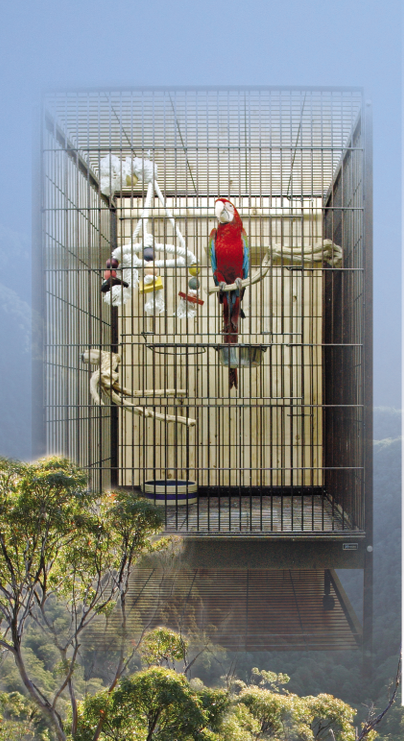
First and foremost, numerous birds do not have the appropriate exposure to versatile housing needed to continuously challenge their instinctive potential for adaptability, prevent cage bonding and territorialism, and provide environmental stimulus.
Without a doubt, providing various environments adapted for your particular avian species within your home can contribute to a healthier and longer lasting relationship with your avian companion.
Undesirable behaviors can be quickly managed and eventually modified when our birds are provided a comfortable and secure retreat or sleeping quarters, an established training stand located in a neutral zone, away from disruptions and a spacious stimulating environment for their day cage. The trend for healthy living is now in vogue for our feathered companions as well as for us. Combining ingenuity, creativity and availability of safer materials for flight construction, outdoor living quarters should be an essential habitat provided for all our companion birds. Regardless of the length of the season this flight will be used or the space available for this outdoor retreat, no bird should be deprived of fresh air and wind to ruffle up their feathers when weather permits! A reliable flight harness should also be considered when acquiring your bird, as this will also contribute to versatile living and you will gain credibility as a responsible guardian. An avian transport cage should be purchased and adapted prior to bringing your companion into your home.
Let’s elaborate on the function behind of each of these living environments, contributing to versatile housing for your avian companion.
Function: To promote an enriching and stimulating environment for your bird to spend the most active part of his day.
Similar to a child’s day care the cage must be safe, bird friendly and suitable for occupational therapy such as:
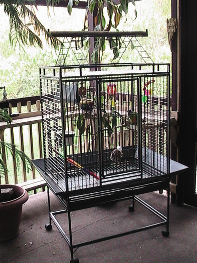
Position within your home: the day cage should ideally be placed in the most spacious room possible, where daylight illuminate the room, ideally a smoke free and bird friendly environment. This is where the majority of the bird will spend its day and so many opt to add vinyl tiles surrounding the cage floor and on the cage bottom tray to accommodate for the extra mess. Obviously a room with carpet is not the ideal. Should your neighbors not appreciate or tolerate the screams of your beloved pet, the day cage could be placed in a distant room or basement, provided there is plenty of daylight (a full spectrum lighting alternative) a fresh and well ventilated room and all the recommended criteria’s for optimal health are met… there is nothing cruel about that in my opinion!
Perches: try to incorporate 3 different types of perches in the day cage. A chewable non toxic wood perch, Manzanita or java wood, plastic perches near water bowls (as these are the easiest to clean thoroughly) , a grooming perch and rope perch. The disposition of the perches and feeding dishes, toys and foraging material should be placed to promote exercise. Unless your avian companion suffers from a disability, do not try to accommodate him too much by placing everything for his convenience. Perch to perch directly leading to a feeding dish without requiring any physical effort… may lead to obesity!
Caution: do not allow the bird to perch on the cage wire frame when out of its cage as this may lead to pododermatitis. Suggestion: affix a wooden perch with tie wraps that can be replaced when needed, or use swirling rope perches, or better yet place an exercise play gym accessible from the day cage.
Feeding & Watering: an optimum extruded diet should be available at all times in the day cage. In the late afternoon additional treats and seeds, fruits and veggies can be offered in the day cage ideally in a separate feeding dish. I recommend placing a water bottle suitable for your avian species, as well as a stainless or ceramic water dish. Offering a fresh supply of quality drinking water each day is essential for optimum care. Plastic is not recommended for water dishes as I fear bacterial contamination adheres more to the inside corners, difficult to clean even with a toothbrush! Clean and disinfect the water bottles daily and replenish with fresh water even though its capacity to hold water is for a few days.
Liners: substrate, cage liners can be placed in the bottom tray of the day cage… unlike the sleeping refuge cage where I recommend the use of paper or recycled newspaper only. Although it is recommended to have a bottom wire grill if you are to place a substrate such as wood shavings, corn kernels or recycled newspaper litter to prevent your bird to come in contact with soiled or spoiled litter.
Lighting: a full spectrum lighting fixture close to the day cage is recommended for a minimum of 5 hours or more per day despite the exposure to daylight the bird receives.
Remember: the beneficial rays of sunlight are filtered by glass windows and excessive heat can also be emitted by exposure to direct sunlight.
Accustoming your pet to a small carrier helps reduce their stress level when transportation is required.
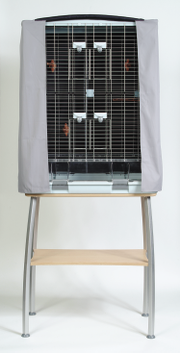
Position within your home: peaceful, undisturbed area or room (not in your kitchen, beside the refrigerator, or near the T.V!) converting an unused closet, under stairway space, attic or basement are ideal for the sleeping quarters. Size can be smaller than the day cage. I recommend using the 1st cage purchased for weaning and fledgling age to be converted to use as a night- refuge cage. If your bird can comfortably spread its wings and its tail does not touch the bottom of the cage then it can be suitable. This cage can also be used for boarding and outings to the cottage. This cage is also a refuge and should be used as such when your bird (yourself or other family members!) could benefit from a time-out. As recommended to dog owners, the training cage will eventually become its sleeping and refuge hideaway.
Feeding & Watering: to ensure optimum nutrition only a formulated extruded granule diet and a clean fresh water bowl should be offered in the sleeping cage as this will be your birds’ healthy breakfast each morning.
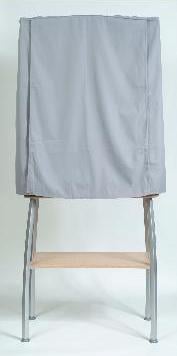
Lighting: the cage should have night blanket adjusted to fit the cage. The addition of a night lamp is recommended for night thrashing species such as cockatiels.
Liners: substrate should be newspaper as morning droppings will be indicative of birds eating behavior and health. Unusual droppings can often signal a health condition that should be monitored.
No toys recommended for the sleeping cage – this is a place for rest, there is no need for stimulation of the senses when your tired parrot needs to sleep… undisrupted! This is also not the time to have an un-groomed toy tangle up around your bird’s head! Some species enjoy sleeping tents, and nesting cavities.
Perches: a comfortable and sturdy perch is recommended, although not a cement perch as overnight perching is too much exposure for their soft feet on such rough or hard surface!
This is the perfect place to teach basic commands. I would recommend that no food be placed in the feeding dishes during these sessions.
The stand should be placed in a neutral zone, away from disturbances for training sessions. As we would when our children must concentrate and focus on their homework, no diversions needed to disrupt their attention.
Relocate the training stand near your kitchen during meal Ppreparations , and review the training lessons with small food rewards, such a pieces of your cut veggies or pasta string, this can be an interactive way to spend quality time with your bird.
Indispensable for emergency transport.
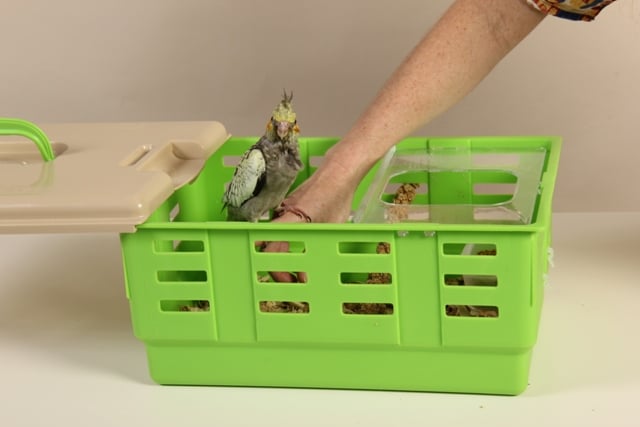
Your parrot should be placed in this transporter periodically, to accustom your pet to this environment when not in a stress situation, in transport or injured. I would recommend 2-3 times per week for 20 minutes, install feeding dishes and patiently wait to see if your bird will get accustomed to this small enclosed environment and feel comfortable enough to eat. Gradually start taking it out for a car ride and visit a friend. Should there be crises such as a sudden evacuation of your home for a fire, or a change of life whereby you are forced to relocate and your companion bird must live in a transport cage during the move, then the transition and change of environment will be easier to adapt for your feathered companion.
Note: the transporter should be bought along with the initial purchase of any new bird. It is primordial that it be safely adapted for each species’ individual comfort.
Location within your home: the transporter should be stored near the day or night cages, easily accessible, clean, equipped with a stable perch, feeding dishes and newspaper bottom. It should definitely not be stored away on the top shelf of the shed or garage where rodents and spiders will have comfortably settled into it and you must borrow the neighbor’s stepladder to reach it!
Depending, your geographical location, seasonal temperatures, municipal by- laws, feasibility, considerations for the birds safety from predators etc various possibilities of either custom building an outdoor flight or purchasing a large outdoor cage should be evaluated. Environmental enrichment, fresh air and natural sunlight, scents and sounds will greatly contribute to the versatile lifestyle of your companion parrot.
By: Josee Bermingham
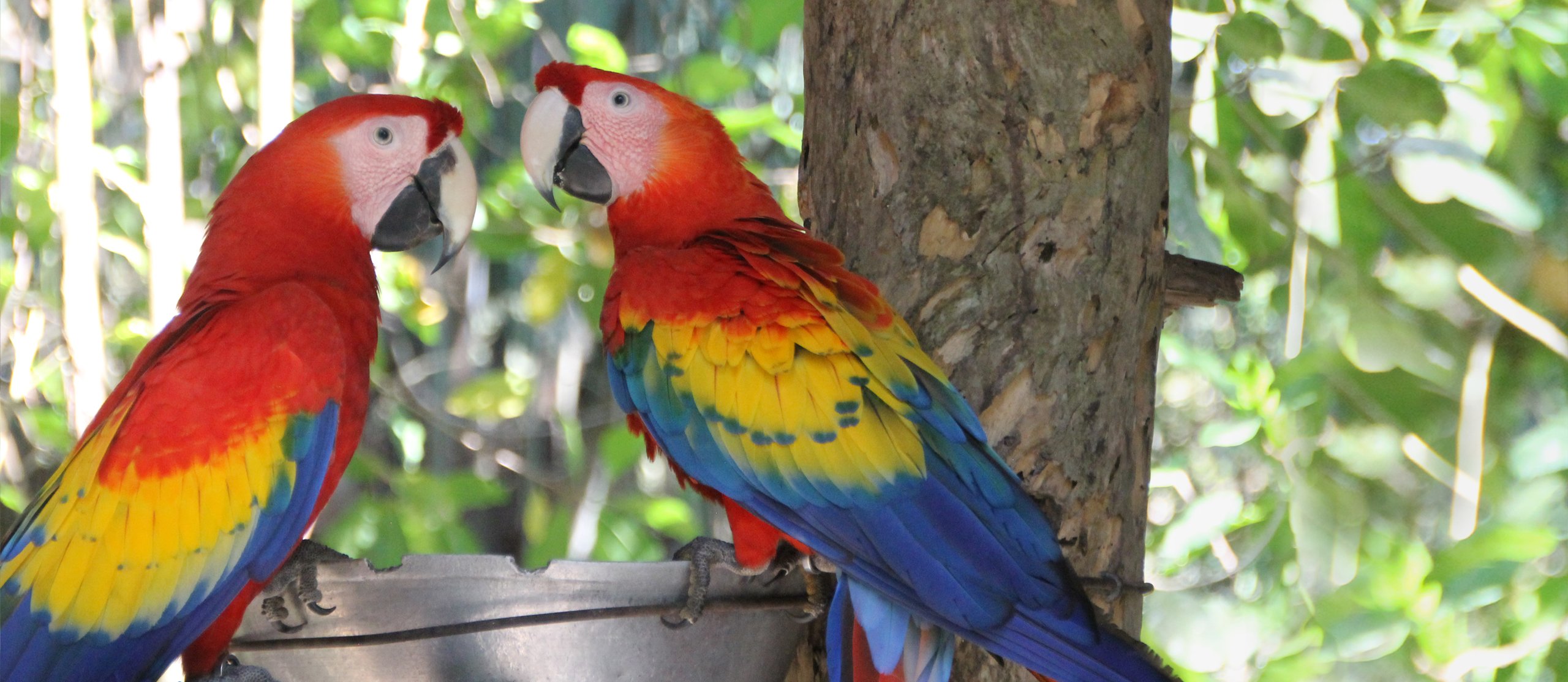
We’re here to help you with everything bird-related! Discover more about parrot conservation, browse conferences and events in your area, connect with local bird clubs, locate a vet or parrot rescue nearby, and read up on fascinating avian news and articles.